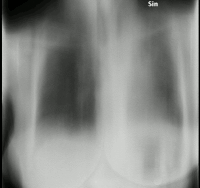
Photo from wikipedia
Digital breast tomosynthesis (DBT) is a new technology that is being used more frequently for both breast cancer screening and diagnostic purposes and its utilization is likely to continue to… Click to show full abstract
Digital breast tomosynthesis (DBT) is a new technology that is being used more frequently for both breast cancer screening and diagnostic purposes and its utilization is likely to continue to increase over time. The major benefit of tomosynthesis over 2D-mammography is that it allows radiologists to view breast tissue using a three-dimensional dataset and improves diagnostic accuracy by facilitating differentiation of potentially malignant lesions from overlap of normal tissue. In addition, image processing techniques allow reconstruction of two dimensional synthesized mammograms (SM) from DBT data, which eliminates the need for acquiring two dimensional full field digital mammography (FFDM) in addition to tomosynthesis and thereby reduces the radiation dose. DBT systems incorporate a moveable x-ray tube, which moves in a prescribed way over a limited angular range to obtain three-dimensional data of patients' breasts, and utilize reconstruction algorithms. The limited angular range for DBT leads to incomplete sampling of the object, and a movable x-ray tube prolongs the imaging time, both of which make DBT and SM susceptible to artifacts. Understanding the etiology of these artifacts should help radiologists in reducing the number of artifacts and in differentiating a true finding from one related to an artifact, thus potentially decreasing recall rates and false positive rates. This is becoming especially important with increased incorporation of DBT in practices around the world. The goal of this article is to review the physics principles behind DBT systems and use these principles to explain the origin of artifacts that can limit diagnostic evaluation.
Journal Title: Clinical imaging
Year Published: 2018
Link to full text (if available)
Share on Social Media: Sign Up to like & get
recommendations!